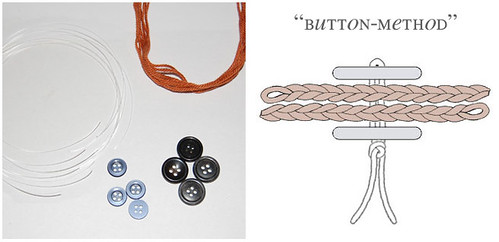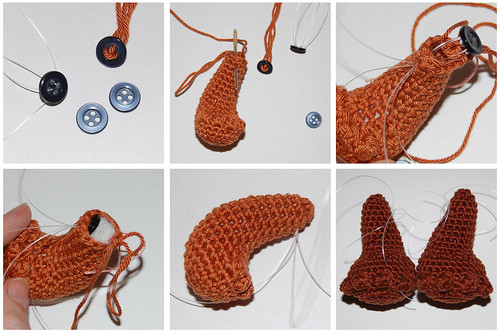The classic amigurumis arms or legs are either sewn on or crocheted to the body (like my trolls or critters). Some dolls even have arms or legs that are part of the body (like my fairies or human like dolls).
But then you find a pattern for a doll and find that you would like to have this doll with movable arms or legs so you can pose your doll; Barney is a doll that's been designed with arms and legs that are movable.
Today I want to show you how to use classic bear joints for your amigurumi dolls and I want to show you how to create a neat alternative in case you don't want to use classic joints (maybe you can't find them or they don't fit)
Classic bear joints are most often three- or sometimes four-piece joints. They can contain disks and washers and wobble pins or nut and bolts, some joints resemble classic safety eyes:
But then you find a pattern for a doll and find that you would like to have this doll with movable arms or legs so you can pose your doll; Barney is a doll that's been designed with arms and legs that are movable.
Today I want to show you how to use classic bear joints for your amigurumi dolls and I want to show you how to create a neat alternative in case you don't want to use classic joints (maybe you can't find them or they don't fit)
Classic bear joints are most often three- or sometimes four-piece joints. They can contain disks and washers and wobble pins or nut and bolts, some joints resemble classic safety eyes:
you could even use safety eyes as joints
___________
now, how do you install them? the standard method would be to place one part of the joint inside your dolls body and the matching part into the arm or leg:
1 - crochet all legs and arms before crocheting the body
2 - don't stuff just yet
3 - add one part of the joint to the e.g. leg: place one disk/disk with shank inside the leg, position it at the inside of the leg, add the washer and bolt resp. washer and wobble pin by pushing the pin or bolt through your material
4 - stuff
5 - close leg (maybe crochet the last row and bind off)
sources for classic joints:
mohairbearmakingsupplies.co.uk
the lovely Clara from 6060 on etsy
there are plenty other resources as well
___________
The alternative to this classic joints would be what I would call "button-joints". Sometimes classic joints are really hard to find or (which I found to be a problem) they just don't fit through two layers of crocheted fabric. Another reason to search for an alternative would be the size of the classic joints would be either too small or too big for your dolls arms or legs.
The "button joint" can be easily adapted to solve any of this problems. Pick smaller buttons to fit small arms/legs, you can find buttons everywhere (I like to use those blouse-buttons that I would keep in case I would ever need them again, but of couse never did) and since you're using yarn to built the joint you can use it for the thickest fabrics as well.
The "button joint" can be easily adapted to solve any of this problems. Pick smaller buttons to fit small arms/legs, you can find buttons everywhere (I like to use those blouse-buttons that I would keep in case I would ever need them again, but of couse never did) and since you're using yarn to built the joint you can use it for the thickest fabrics as well.
what you need and what the button joint will look like:
buttons (find some that fit into arms and legs easily, you can choose bigger ones for the body) and yarn or other tear-proof thread like fishing line.
how to do it:
1 - prepare your buttons: cut yarn or fishing line to pieces of about 10"/25cm and pull them through your buttons as pictured
2 - pull the fishing line/yarn ends through one layer of your leg/arm, be careful to position at the inner side of each arm/leg, so you don't accidentally will receive arms or legs that face the wrong way
3 - stuff
4 - finish leg or arm (crochet last round and bind off, hide yarn ends)
5 - now find the position on your dolls body where the arms/ legs will be attached
6 - pull the fishing line/yarn ends which are coming from the inside of an arm or leg through an hole in your bodys fabric
7 - push a button over the yarn/fishing line ends (space them evenly)
8 - tie knot (fix with a drop of glue if you like to make it extra secure)
Again it's very helpful to crochet the arms/legs before you start the body, this way you can add the prepared arms and legs when needed and stuff and finish the body afterwards.
I like this method very much and will use it again on other dolls. I also was very surprised that the button-joint was a lot less wonky than I had expected.
Hope you liked this tutorial and find it useful,
take care
Diana
I like this method very much and will use it again on other dolls. I also was very surprised that the button-joint was a lot less wonky than I had expected.
Hope you liked this tutorial and find it useful,
take care
Diana





Thank you a lot! This really helped me making amigurumis with moveable arms and legs :) I especially liked the "button-method" :D
AntwortenLöschen/Sofie in Sweden
yay :) I hoped it would be helpful for someone :) I like my button method as well, it's so easy and versatile :)
AntwortenLöschenbest wishes, Diana
This is a Great tutorial, I will use it to make my amigurumi patterns better!Thanks! (love the button method.)
LöschenWonderful! Thank You so much for the excellent tutorial! Amy from Wisconsin, USA
AntwortenLöschen